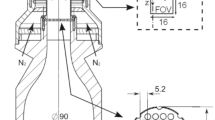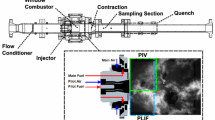Abstract
Particle image velocimetry (PIV) estimates the fluid velocity field measuring the displacement of small dispersed particles between two successive instants separated by a small time interval. The accuracy of the measurements depends on the ability of the particles to accommodate their velocity to the fluid fluctuations. When the fluid is subjected to extreme accelerations, the small but finite inertia prevents the particles from following the fluid, originating a substantial relative velocity. This effect is shown to be crucial for applications of PIV to turbulent premixed combustion, particularly in the product region at locations just behind the instantaneous flame front. The issuing inaccuracy may easily spoil the estimate of certain statistical observables which are of crucial importance in the theory of turbulent premixed combustion. By exploiting the direct numerical simulation of a model air/methane flame, a suitable criterion for proper particle seeding is validated and compared with the corresponding experiments with a combined PIV/OH-LIF (laser-induced fluorescence) system. The proposed parameter, the flamelet Stokes number, depends on particle properties and thermochemical conditions of the flame and substantially restricts the particle dimensions required for a reliable estimate of the relevant flow statistics.

















Similar content being viewed by others
References
Balkovsky R, Falkovich G, Fouxon A (2001) Intermittent distribution of inertial particles in turbulent flows. Phys Rev Lett 86:2790
Bec J, Celani A, Cencini M, Musacchio S (2005) Clustering and collisions of heavy particles in random smooth flows. Phys Fluids, 17:073301
Bec J, Biferale L, Cencini M, Lanotte A, Musacchio S, Toschi F (2007) Heavy particle concentration in turbulence at dissipative and inertial scales. Phys Rev Lett 98(8):084502
Bergthorson JM, Dimotakis PE (2006) Particle velocimetry in high-gradient/high-curvature flows. Exp Fluids 41:255–263
Boxx I, Stöhr M, Carter C, Meier W (2010) Temporally resolved planar measurements of transient phenomena in a partially pre-mixed swirl flame in a gas turbine model combustor. Combust Flame in press. doi:10.1016/j.combustflame.2009.12.015
Bray KNC, Libby PA, Moss JB (1995) Unified modeling approach for premixed turbulent combustion–part i: general formulation. Combust Flame 61(1):87–102
Corrsin S, Kistler AL (1954) Technical Report 3133, NACA
Frank JH, Kalt PAM, Bilger RW (1999) Measurements of conditional velocities in turbulent premixed flames by simultaneous oh plif and piv. Combust Flame 116:220–232
Goto S, Vassilicos JC (2006) Self-similar clustering of inertial particles and zero-acceleration points in fully developed two-dimensional turbulence. Phys Fluids 18(11):115103
Gualtieri P, Picano F, Casciola CM (2009) Anisotropic clustering of inertial particles in homogeneous shear flow. J Fluid Mech 629:25
Han D, Mungal MG (2003) Simultaneous measurements of velocity and ch distributions. Part 1: jet flames in co-flow. Combust Flame 132:565–590
Kee RJ, Rupley FM, Meeks E, Miller JA (1996) CHEMKIN-III: a FORTRAN chemical kinetics package for the analysis of gas-phase chemical and plasma kinetics. Sandia national laboratories report SAND96-8216
Law CK (2006) Combustion physics. Cambridge University Press, Cambridge
Majda A, Sethian J (1985) The derivation and numerical solution of equation for zero mach number combustion. Combust Sci Tech 42:185
Maxey MR, Riley JJ (1983) Equation of motion for a small rigid sphere in a nonuniform flow. Phys Fluids 26(4):883
Peters N (2000) Turbulent combustion. Cambridge University Press, Cambridge
Picano F, Casciola CM (2007) Small-scale isotropy and universality of axisymmetric jets. Phys Fluids 19(11):118106
Picano F, Sardina G, Casciola CM (2009) Spatial development of particle-laden turbulent pipe flow. Phys Fluids 21(9):093305
Poinsot T, Veynante D, Candel S (1991) Quenching processes and premixed turbulent combustion diagrams. J Fluid Mech 228:561–606
Reeks MW (1983) The transport of discrete particles in inhomogeneous turbulence. J Aerosol Sci 14(6):729–739
Righetti M, Romano GP (2004) Particle–fluid interactions in a plane near-wall turbulent flow. J Fluid Mech 505:93–121
Rouson DWI, Eaton JK (2001) On the preferential concentration of solid particles in turbulent channel flow. J Fluid Mech 428:149
Shoshin Y, Gorecki G, Jarosinski J, Fodemski T (2010) Experimental study of limit lean methane/air flame in a standard flammability tube using particle image velocimetry method. Combust Flame 157(5):884–892
Sreenivasan KR, Meneveau C (1986) The fractal facets of turbulence. J Fluid Mech 173:357
Steinberg AM, Driscoll JF, Ceccio SL (2008) Measurements of turbulent premixed flame dynamics using cinema stereoscopic PIV. Exp Fluids 44(6):985–999
Stella A, Guj G, Kompenhans J, Raffel M, Richard H (2001) Application of particle image velocimetry to combusting flows: design considerations and uncertainty assessment. Exp Fluids 30:167–180
Sung CJ, Law CK, Axelbaum RL (1994) Thermophoretic effects on seeding particles in ldv measurements of flames. Combust Sci Tech 99:119–132
Tieszen SR, O’Hern TJ, Weckman EJ, Schefer RW (2004) Experimental study of the effect of fuel mass flux on a 1-m-diameter methane fire and comparison with a hydrogen fire. Combust Flame 139(1–2):126–141
Troiani G (2009) Effect of velocity inflow conditions on the stability of a ch4/air jet-flame. Combust Flame 156(2):539–542
Troiani G, Marrocco M, Giammartini S, Casciola CM (2009) Counter-gradient transport in the combustion of a premixed ch4/air annular jet by combined piv/oh-lif. Combust Flame 156(3):608–620
Waterson NP, Deconinck H (2007) Design principles for bounded higher-order convection schemes—a unified approach. J Comput Phys 224:182–207
Willert C, Hassa C, Stockhausen G, Jarius M, Voges M, Klinner J (2006) Combined piv and dgv applied to a pressurized gas turbine combustion facility. Meas Sci Technol 17:1670–1679
Author information
Authors and Affiliations
Corresponding author
Appendix A: Eulerian formulation of particle velocity
Appendix A: Eulerian formulation of particle velocity
In this appendix, we discuss a procedure to derive a continuum particle velocity field in terms of particle velocities in the limit of small τ p . Starting from Eq. (2), we obtain the fluid velocity along the particle trajectory as the solution of dx p /dt = v p ,
This allows to express the time derivative of the fluid velocity experienced by the particle as
The above expression yields
which, rearranged as an expression for \(\dot{v}_p\) to be inserted in (14), provides the fluid velocity as:
It follows
Since both fluid velocity and acceleration are Eulerian fields, Eq. (18) defines an equivalent Eulerian particle velocity field by neglecting corrections of order \(\tau_p^2,\)
In this approximation, the particle velocities are treated as a single valued field. In its use one should be aware of the possible existence of caustics corresponding to a multi-valued particle velocity at the same position (Bec et al. 2005).
Rights and permissions
About this article
Cite this article
Picano, F., Battista, F., Troiani, G. et al. Dynamics of PIV seeding particles in turbulent premixed flames. Exp Fluids 50, 75–88 (2011). https://doi.org/10.1007/s00348-010-0896-y
Received:
Revised:
Accepted:
Published:
Issue Date:
DOI: https://doi.org/10.1007/s00348-010-0896-y




